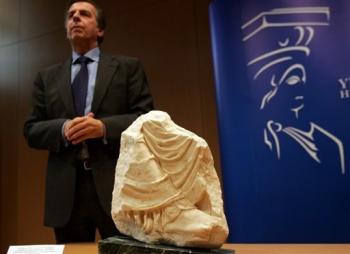It’s not any of the major pieces of the Parthenon frieze controversially housed in the British Museum. Lord Elgin gave this fragment to the British consul-general of Sicily when he was passing through with his ill-gotten gain in 1816.
It’s been in Sicily ever since, and now it’s finally home, personally transported to Athens by Italian President Giorgio Napolitano.
The sculpted fragment of the ancient Greek hunt goddess Artemis, part of the eastern Parthenon frieze depicting the twelve gods of Olympus, had been in the collection of the Antonio Salinas Archaeological Museum of Palermo.
Greece had sought to secure its return for 13 years, the Greek culture minister said.
The fragment depicts the goddess’ right foot and part of her long robe.
“For the first time in nearly two centuries, a valuable fragment of the Parthenon’s sculpted decoration returns to be embodied where it belongs,” Culture Minister Michalis Liapis told reporters.
Hint, hint. Ever since the New Acropolis Museum opened, Greece has been putting serious pressure on the British Museum to return the Parthenon Marbles.
The BM hasn’t been receptive to Greek entreaties, needless to say. Collecting fragments of the frieze scattered about is a great way to keep the situation in the papers and to make the British Museum look like a dick for not being willing to even consider what other countries are doing.

Edit for clarification: The piece is on loan to Greece. It will return to the Palermo museum at the end of the year.
:hattip: commenter Mark Watson
Oh, wow, good for Italy! I think you’re right, this is a perfect way to not only return the pieces to their home but will hopefully make the BM jerks feel a teeny tiny bit of shame for being, as you said, dicks.
I hope they feel a pang or two, but I fear that at this point, the BM is too vested in its centuries-old rationalizations to even begin to reconsider their stance. 🙁
This is actually a loan, not a gift (or restitution). The loan runs through to December 31. See the news item on ansamed.
Ah, gotcha. Thank you for the tip. I’ve edited to clarify.
Sorry, GB legitemately owns the Elgin Marbles, The Ottomans gave Elgin a permit to remove them, and the British government later *paid* Elgin for them and plunked them into the museum.
To be perfectly honest, if they hadn’t been removed from the Parthenon, they would have been blown up at the same time as the rest of the building when it was shelled.
The authenticity of the firman that Elgin claimed granted him permission to remove the Parthenon frieze is questionable, to say the very least. It was highly controversial at the time and hasn’t become any less so now that the original document has been lost. There’s also an ethical question about removing cultural patrimony from occupied countries just because the occupiers say you can. Again, this was a hotly debated point at the time. Many prominent people in British arts and government thought Elgin was nothing more than a barbarian and a thief. To top it all off, he brutalized the Parthenon in removing the frieze, and then the British Museum brutalized the marbles with shockingly abrasive “cleaning” methods just because they wanted them as white as can be in keeping with their fantasy of what ideal classical architecture should be.
As for the notion that the frieze would have “blown up at the same time as the rest of the building when it was shelled,” the Parthenon is still standing proud, and the elements of it that are too delicate to remain outside are now housed in a spectacular new museum that is as state-of-the-art as it is beautiful. The frieze would be entirely protected there, and visitors could see it in its proper context.
Legitimacy is not so easily assessed with a “sorry” and a declarative sentence or two.